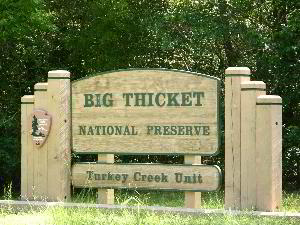|
==============================================================================
TOPIC: Big Thicket National Preserve, TX
http://groups.google.com/group/entstrees/browse_thread/thread/d37717fb9cc1fe9f?hl=en
==============================================================================
== 1 of 2 ==
Date: Mon, Jan 28 2008 8:23 pm
From: "Edward Frank"
The Big Thicket National Preserve, TX
The big Thicket National Preserve in east Texas is a site that
deserves some attention form ENTS. The preserve contains a wide
variety of tree and shrub species, including among others bald
cypress of impressive sizes. I visited the area on July 10, 2005.
The trip there was interesting. I left a motel just west of Congaree
National Park the morning of July 9th. My plan was to head to
Louisiana to visit one of the wildlife refuges in the delta. As I
approached from the north along 55 in Mississippi there was a lot of
traffic flowing northward. As I continued south there was a massive
storm ahead. Soon it was raining so hard I could not see to drive. I
turned around at a crossing and headed back. north. These were the
leading frontal storms from Hurricane Dennis. It was a massively
wide storm stretching across much of the Caribbean and the southern
coast of the United States. It was the strongest storm in 150 years.
The hurricane sort of fizzled out and dropped to a category 3 before
hitting Florida, but today its impact was being felt hundreds of
miles away. I headed northward, fleeing before the storm. I have a
photo below taken in Jackson, MS (strains of the Rolling Stones in
the background) where I stopped briefly to buy a new battery for my
camera.

My goal was to find a motel that evening and move on to the Big
Thicket the next day. However people were evacuating all along the
gulf coast and the motels were full. I drove on into the night,
through Arkansas, and into Texas, before finally finding a motel
just north of the Big Thicket. The next morning I continued on to
the Big Thicket.

I stopped at the visitors center to get some literature and to
decide where I would go that day. The park website http://www.nps.gov/bith/index.htm
and also http://www.nps.gov/archive/bith/home.htm
provides a good overview of the diversity of the Preserve.
"People have called the Big Thicket an American ark and the
biological crossroads of North America. The preserve was established
to protect the remnant of its complex biological diversity. What is
extraordinary is not the rarity or abundance of its life forms, but
how many species coexist here. Once vast, this combination of pine
and cypress forest, hardwood forest, meadow, and blackwater swamp is
but a remnant. With such varied habitats, "Big Thicket" is
a misnomer, but it seems appropriate. An exhausted settler wrote in
1835: "This day passed through the thickest woods I ever saw.
It...surpasses any country for brush."
"Major North American biological influences bump up against
each other here: south eastern swamps, eastern forests, central
plains, and southwest deserts. Bogs sit near arid sandhills. Eastern
bluebirds nest near roadrunners. There are 85 tree species, more
than 60 shrubs, and nearly 1,000 other flowering plants, including
26 ferns and allies, 20 orchids, and four of North America's five
types of insect-eating plants. Nearly 186 kinds of birds live here
or migrate through. Fifty reptile species include a small, rarely
seen population of alligators. Amphibious frogs and toads
abound."
'The Preserve consists of nine land units and six water corridors
encompassing more than 97,000 acres. Big Thicket was the first
Preserve in the National Park System established October 11, 1974,
and protects an area of rich biological diversity. A convergence of
ecosystems occurred here during the last Ice Age."
In addition to being designated a United States National Preserve,
In 1981 Big Thicket National Preserve was added to the list of
International Biosphere Reserves by United Nations UNESCO Man and
the Biosphere program. On July 26, 2001, the American Bird
Conservancy designated Big Thicket National Preserve a Globally
Important Bird Area (IBA).
I visited the Kirby Nature Trail: "Located in the southern
end of the Turkey Creek Unit near the Staley Cabin, this trail, part
of a larger system, is a popular double loop trail. The inner loop
is 1.7 miles and the outer loop 2.4 miles. The trail meanders
through a mixture of hardwoods and pines as well as several types of
environments including Bald cypress swamps. As it passes Village
Creek, you will see small floodplains. A guide is available at the
trailhead."
I would strongly encourage ENTS visiting this area to visit the
Big Thicket. In addition to big trees, there are assortments of
uncommon to rare plants including several species of pitcher plants,
among others. Camping is permitted, but only back country camping as
there are no formal campgrounds within the Preserve. Certainly worth
the visit.
Ed Frank
"I am not bound to please thee with my answers."
William Shakespeare
|